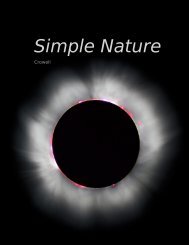The size of a radio antenna is closely related to ... - Light and Matter
The size of a radio antenna is closely related to ... - Light and Matter
The size of a radio antenna is closely related to ... - Light and Matter
Create successful ePaper yourself
Turn your PDF publications into a flip-book with our unique Google optimized e-Paper software.
our intuitive expectation <strong>of</strong> strong absorption <strong>of</strong> sound in water <strong>is</strong><br />
incorrect. Water <strong>is</strong> a very weak absorber <strong>of</strong> sound (viz. whale songs<br />
<strong>and</strong> sonar), <strong>and</strong> our incorrect intuition ar<strong>is</strong>es from focusing on the<br />
wrong property <strong>of</strong> the substance: water’s high density, which <strong>is</strong><br />
irrelevant, rather than its low v<strong>is</strong>cosity, which <strong>is</strong> what matters.<br />
<strong>Light</strong> <strong>is</strong> an interesting case, since although it can travel through<br />
matter, it <strong>is</strong> not itself a vibration <strong>of</strong> any material substance. Thus<br />
we can look at the star Sirius, 10 14 km away from us, <strong>and</strong> be assured<br />
that none <strong>of</strong> its light was absorbed in the vacuum <strong>of</strong> outer<br />
space during its 9-year journey <strong>to</strong> us. <strong>The</strong> Hubble Space Telescope<br />
routinely observes light that has been on its way <strong>to</strong> us since the<br />
early h<strong>is</strong><strong>to</strong>ry <strong>of</strong> the universe, billions <strong>of</strong> years ago. Of course the<br />
energy <strong>of</strong> light can be d<strong>is</strong>sipated if it does pass through matter (<strong>and</strong><br />
the light from d<strong>is</strong>tant galaxies <strong>is</strong> <strong>of</strong>ten absorbed if there happen <strong>to</strong><br />
be clouds <strong>of</strong> gas or dust in between).<br />
Soundpro<strong>of</strong>ing example 11<br />
Typical amateur musicians setting out <strong>to</strong> soundpro<strong>of</strong> their garages<br />
tend <strong>to</strong> think that they should simply cover the walls with the<br />
densest possible substance. In fact, sound <strong>is</strong> not absorbed very<br />
strongly even by passing through several inches <strong>of</strong> wood. A better<br />
strategy for soundpro<strong>of</strong>ing <strong>is</strong> <strong>to</strong> create a s<strong>and</strong>wich <strong>of</strong> alternating<br />
layers <strong>of</strong> materials in which the speed <strong>of</strong> sound <strong>is</strong> very different,<br />
<strong>to</strong> encourage reflection.<br />
<strong>The</strong> classic design <strong>is</strong> alternating layers <strong>of</strong> fiberglass <strong>and</strong> plywood.<br />
<strong>The</strong> speed <strong>of</strong> sound in plywood <strong>is</strong> very high, due <strong>to</strong> its stiffness,<br />
while its speed in fiberglass <strong>is</strong> essentially the same as its speed<br />
in air. Both materials are fairly good sound absorbers, but sound<br />
waves passing through a few inches <strong>of</strong> them are still not going<br />
<strong>to</strong> be absorbed sufficiently. <strong>The</strong> point <strong>of</strong> combining them <strong>is</strong> that<br />
a sound wave that tries <strong>to</strong> get out will be strongly reflected at<br />
each <strong>of</strong> the fiberglass-plywood boundaries, <strong>and</strong> will bounce back<br />
<strong>and</strong> forth many times like a ping pong ball. Due <strong>to</strong> all the back<strong>and</strong>-forth<br />
motion, the sound may end up traveling a <strong>to</strong>tal d<strong>is</strong>tance<br />
equal <strong>to</strong> ten times the actual thickness <strong>of</strong> the soundpro<strong>of</strong>ing before<br />
it escapes. Th<strong>is</strong> <strong>is</strong> the equivalent <strong>of</strong> having ten times the<br />
thickness <strong>of</strong> sound-absorbing material.<br />
Radio transm<strong>is</strong>sion example 12<br />
A <strong>radio</strong> transmitting station must have a length <strong>of</strong> wire or cable<br />
connecting the amplifier <strong>to</strong> the <strong>antenna</strong>. <strong>The</strong> cable <strong>and</strong> the <strong>antenna</strong><br />
act as two different media for <strong>radio</strong> waves, <strong>and</strong> there will<br />
therefore be partial reflection <strong>of</strong> the waves as they come from the<br />
cable <strong>to</strong> the <strong>antenna</strong>. If the waves bounce back <strong>and</strong> forth many<br />
times between the amplifier <strong>and</strong> the <strong>antenna</strong>, a great deal <strong>of</strong> their<br />
energy will be absorbed. <strong>The</strong>re are two ways <strong>to</strong> attack the problem.<br />
One possibility <strong>is</strong> <strong>to</strong> design the <strong>antenna</strong> so that the speed <strong>of</strong><br />
the waves in it <strong>is</strong> as close as possible <strong>to</strong> the speed <strong>of</strong> the waves<br />
364 Chapter 6 Waves














